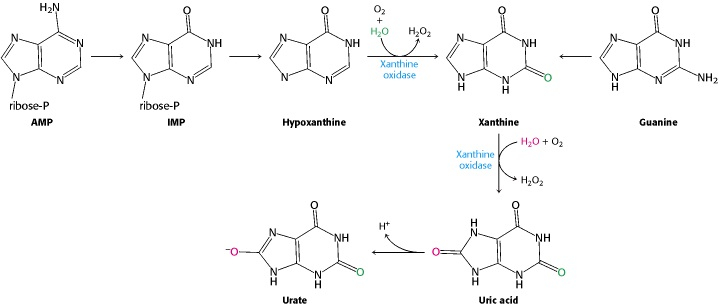

| MadSci Network: Biochemistry |
Hi Catherine,
Since you’ve already read through the answers in our archives about caffeine, as well as our caffeine FAQ page, and not found the answers to your question, the next step is to go to the primary literature; this is where basic scientific research is published.
So, I went to PubMed and looked for articles about caffeine biosynthesis, and found the following information.
As you probably know, caffeine is the chemical known as 1,3,7-trimethylxanthine; that means that it is a xanthine molecule with three methyl (-CH3) groups in place of three hydrogens. Xanthine is a product of the purine degradation pathway, in which purine nucleic acids are converted to uric acid for excretion.
So, to synthesize caffeine, xanthine is methylated (a methyl group is added) to form 7- methylxanthine, 7-methylxanthine is further methylated to form 3,7-Dimethylxanthine (which is also known as theobromine), and theobromine is further methylated to generate 1,3,7- trimethylxanthine, or caffeine.
These steps are illustrated in Figure 1 (showing the purine catabolism pathway) and Figure 2 (showing the caffeine synthesis pathway) below.

|
|

|
The three methylation steps in Figure 2 are carried out by two N-methyltransferase enzymes; these are denoted in Figure 2 as XMT, which stands for xanthosine methyltransferase, and DMXT, which stands for 1,7-dimethylxanthine methyltransferase; DMXT is also known by the name caffeine synthase. Note that caffeine synthase is responsible for generating both theobromine and caffeine.
So, there you have it, an overview of caffeine synthesis. For more information, including which plants these molecules and enzymes where originally found in, and where in the plant these reactions occur, you can take a look at these papers that describe the research that led to the elucidation of this pathway.
T Suzuki and E Takahashi
Biosynthesis of caffeine by tea-leaf extracts. Enzymic formation of theobromine from 7-
methylxanthine and of caffeine from theobromine.
Biochem J. 1975 January; 146(1): 87–96.
http://www.ncbi.nlm.nih.gov:80/pmc/articles/PMC1165278
Zheng XQ, Koyama Y, Nagai C, Ashihara H.
Biosynthesis, accumulation and degradation of theobromine in developing Theobroma cacao
fruits.
J Plant Physiol. 2004 Apr;161(4):363-9.
http://www.ncbi.nlm.nih.gov/pubmed/15128023
Misako K, Kouichi M.
Caffeine synthase and related methyltransferases in plants.
Front Biosci. 2004 May 1;9:1833-42. Review.
http://www.ncbi.nlm.nih.gov/pubmed/14977590
McCarthy AA, McCarthy JG.
The structure of two N-methyltransferases from the caffeine biosynthetic pathway.
Plant Physiol. 2007 Jun;144(2):879-89.
http://www.ncbi.nlm.nih.gov/pubmed/17434991
Ashihara H, Sano H, Crozier A.
Caffeine and related purine alkaloids: biosynthesis, catabolism, function and genetic
engineering.
Phytochemistry. 2008 Feb;69(4):841-56.
http://www.ncbi.nlm.nih.gov/pubmed/18068204
Try the links in the MadSci Library for more information on Biochemistry.